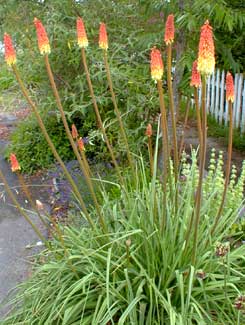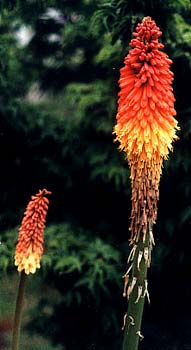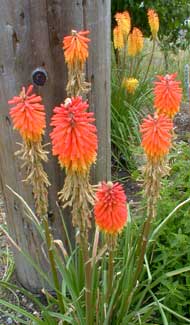
Pfitzer's Red Hot Poker
or Torch Lily
My great-grandmother had red-hot-pokers (Kniphofia uvaria) at the head of a long dirt lane beside a boulder. The area was outside the reach of her garden-watering chores, but the neglected poker plant flourished dramatically, producing more & more pokers every year, which some of the grandkids were apt to pull loose & use for spears, inspiring minimal chastisements. It was dormant but evergreen through winter, & demanded very little pruning back. When I took a very young interest in gardening, Gram Elvie dug up part of her big poker plant & I trundled home to the other end of the lane to plant it in an area that was my own garden.
 So I have been growing these since I was about the age of seven or eight, & even though it can be untidy with many bent blades in its oversized turf mound, I have an inescapable sentimentality toward red-hot-pokers.
So I have been growing these since I was about the age of seven or eight, & even though it can be untidy with many bent blades in its oversized turf mound, I have an inescapable sentimentality toward red-hot-pokers.The basic "matchhead" variety my grandmother had is still the most commonly seen, though there are many named cultivars in other colors, & dwarfed varieties, so that the wild form is being a little displaced from nursery stocks. Fortunately it is such a long-lived plant it is easy to get a start from old traditional varieties.
The one we have growing on the street corner seems to be fairly close to the wild form. It is Pfitzer's Red Hot Poker, of the old-fashioned red & orange & yellow matchhead type, named for Wilhelm Pfitzer, a European plant breeder of the late 1800s & early 1900s.
 Granny Artemis came running in the house one July afternoon exclaiming, "Guess what visited me by the torch lily out back!" "What?" "A hummingbird!" The torches are very full of necter & pollen & even more attractive to hummingbirds than are their beloved honeysuckles.
Granny Artemis came running in the house one July afternoon exclaiming, "Guess what visited me by the torch lily out back!" "What?" "A hummingbird!" The torches are very full of necter & pollen & even more attractive to hummingbirds than are their beloved honeysuckles.Torch Lilies were first brought to England from South Africa in the 1770s, but were not common to English gardening until the middle of the Nineteenth Century. They were for a long time mistaken as only suitable for hothouses, being a tropical African species after all. But in 1848 specimens were placed outdoors at Kew Gardens, & it would have been hard to find a more public place to prove themselves temperate-hardy too.
 By the 1860s they were growing in gardens throughout the British Isles, & were known in Scotland as Baillie Nicol Jarvie's Poker after an incident in Sir Walter Scott's Rob Roy.
By the 1860s they were growing in gardens throughout the British Isles, & were known in Scotland as Baillie Nicol Jarvie's Poker after an incident in Sir Walter Scott's Rob Roy.Their scientific name was originally Tritoma but that was changed to honor Johann Hieronymus Kniphof (1704-1763), who published a famous illustrated herbal. A portrait of Professor Kniphof is shown on this page.
We grew this specimen from two starts so small they would've fit in two-inch pots. In only two years it was a four or five foot tall stand of saber-shaped leaves, with stalks reaching to six feet tall, topped with bright orange & yellow & red flowerheads all through June & July, with occasional rebloom until first frost in autumn. As cut flowers, they last easily two weeks in a bouquet.
It wants bright sun. It gets so large it can be dug up & divided every other year if one wishes. During the hottest days of summer it does need a bit of watering now & then to remain attractive, but needs perfect drainage to not be troubled by winter rains.
The only other care it needs is yearly "under-pruning" as the old saber-leaves dry out & are mashed down by new growth, so that eventually the under-edges of the clump can be unsightly. If the clump becomes overall too floppy, it can be sheered very short, & will pop back tidily.
We also have a bright yellow-blooming cultivar:
Cobra Torch Lily
Cobra Torch Lily